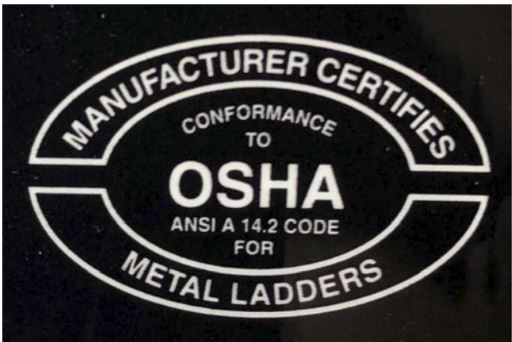Long time readers of Minnesota Litigator will remember our earlier posts about Wing v. Tricam, a dispute between competing ladder manufacturers about the defendant’s claim that its ladder is “OSHA/ANSI Compliant.” (Earlier posts are here, here, and here.) Plaintiff Wing argues that Defendant Tricam’s claim is false advertising.

As is clear from our earlier posts, the multi-year expensive legal dispute nauseates us on several levels. Mostly, it does so because, it seems, a major aspect of the case hinges on the plaintiff’s failure to claim OSHA non-compliance. As a result of that apparent misstep, the case got quite complicated because, as is evident from the label, it is difficult to make the case that the label is false as to ANSI without addressing one way or the other as to whether it is false as to OSHA. This apparent over-sight is the kind of “gotcha” error that civil litigators dread.

The dispute also strikes us as nauseating because we’re talking about ladders here, not super-colliders. That is, ladders are among the most simple and basic tools ever invented by humans (and used by parrots, chickens, cats, dogs, goats, and fish). When people buy ladders, we would respectfully submit that they consider: ladder height, cost, any little add-ons (sturdy feet, useful tray, etc.), and looks (maybe). Basic sturdiness and safety are assumed.
How many buyers do you think know what ANSI 14.2 is and make their purchase decision based meeting that standard?
Undoubtedly, at least some ladder buyers do, particularly sophisticated ladder buyers (that is, large construction or manufacturing businesses, for example). So, we guess it might matter if a ladder manufacturer cut corners and claimed “conformance” with ANSI 14.2 for a ladder that didn’t meet the standard. What percentage of ladder sales do you think that might be?
(Oh, and by the way, the ANSI standard relates to the thickness of step surface on the ladder rungs. So, if buyers really cared about it, maybe they’d simply measure???)
In any event, the United States Court of Appeals for the Federal Circuit has just breathed life back into the Plaintiff Wing’s case, which had been thrown out on defendant’s motion for summary judgment. Wing’s case lives on (in part)! This is good news for Wing, of course, but maybe even better news to the parties’ lawyers and their ever-ascending fees…
